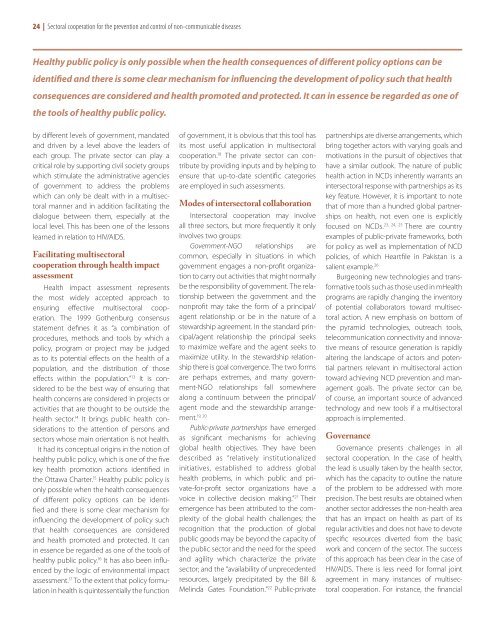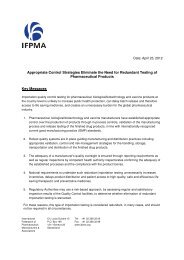Addressing the Gaps in Global Policy and Research for Non ... - IFPMA
Addressing the Gaps in Global Policy and Research for Non ... - IFPMA
Addressing the Gaps in Global Policy and Research for Non ... - IFPMA
You also want an ePaper? Increase the reach of your titles
YUMPU automatically turns print PDFs into web optimized ePapers that Google loves.
24 | Sectoral cooperation <strong>for</strong> <strong>the</strong> prevention <strong>and</strong> control of non-communicable diseases<br />
Healthy public policy is only possible when <strong>the</strong> health consequences of different policy options can be<br />
identified <strong>and</strong> <strong>the</strong>re is some clear mechanism <strong>for</strong> <strong>in</strong>fluenc<strong>in</strong>g <strong>the</strong> development of policy such that health<br />
consequences are considered <strong>and</strong> health promoted <strong>and</strong> protected. It can <strong>in</strong> essence be regarded as one of<br />
<strong>the</strong> tools of healthy public policy.<br />
by different levels of government, m<strong>and</strong>ated<br />
<strong>and</strong> driven by a level above <strong>the</strong> leaders of<br />
each group. The private sector can play a<br />
critical role by support<strong>in</strong>g civil society groups<br />
which stimulate <strong>the</strong> adm<strong>in</strong>istrative agencies<br />
of government to address <strong>the</strong> problems<br />
which can only be dealt with <strong>in</strong> a multisectoral<br />
manner <strong>and</strong> <strong>in</strong> addition facilitat<strong>in</strong>g <strong>the</strong><br />
dialogue between <strong>the</strong>m, especially at <strong>the</strong><br />
local level. This has been one of <strong>the</strong> lessons<br />
learned <strong>in</strong> relation to HIV/AIDS.<br />
Facilitat<strong>in</strong>g multisectoral<br />
cooperation through health impact<br />
assessment<br />
Health impact assessment represents<br />
<strong>the</strong> most widely accepted approach to<br />
ensur<strong>in</strong>g effective multisectoral cooperation.<br />
The 1999 Go<strong>the</strong>nburg consensus<br />
statement def<strong>in</strong>es it as “a comb<strong>in</strong>ation of<br />
procedures, methods <strong>and</strong> tools by which a<br />
policy, program or project may be judged<br />
as to its potential effects on <strong>the</strong> health of a<br />
population, <strong>and</strong> <strong>the</strong> distribution of those<br />
effects with<strong>in</strong> <strong>the</strong> population.” 13 It is considered<br />
to be <strong>the</strong> best way of ensur<strong>in</strong>g that<br />
health concerns are considered <strong>in</strong> projects or<br />
activities that are thought to be outside <strong>the</strong><br />
health sector. 14 It br<strong>in</strong>gs public health considerations<br />
to <strong>the</strong> attention of persons <strong>and</strong><br />
sectors whose ma<strong>in</strong> orientation is not health.<br />
It had its conceptual orig<strong>in</strong>s <strong>in</strong> <strong>the</strong> notion of<br />
healthy public policy, which is one of <strong>the</strong> five<br />
key health promotion actions identified <strong>in</strong><br />
<strong>the</strong> Ottawa Charter. 15 Healthy public policy is<br />
only possible when <strong>the</strong> health consequences<br />
of different policy options can be identified<br />
<strong>and</strong> <strong>the</strong>re is some clear mechanism <strong>for</strong><br />
<strong>in</strong>fluenc<strong>in</strong>g <strong>the</strong> development of policy such<br />
that health consequences are considered<br />
<strong>and</strong> health promoted <strong>and</strong> protected. It can<br />
<strong>in</strong> essence be regarded as one of <strong>the</strong> tools of<br />
healthy public policy. 16 It has also been <strong>in</strong>fluenced<br />
by <strong>the</strong> logic of environmental impact<br />
assessment. 17 To <strong>the</strong> extent that policy <strong>for</strong>mulation<br />
<strong>in</strong> health is qu<strong>in</strong>tessentially <strong>the</strong> function<br />
of government, it is obvious that this tool has<br />
its most useful application <strong>in</strong> multisectoral<br />
cooperation. 18 The private sector can contribute<br />
by provid<strong>in</strong>g <strong>in</strong>puts <strong>and</strong> by help<strong>in</strong>g to<br />
ensure that up-to-date scientific categories<br />
are employed <strong>in</strong> such assessments.<br />
Modes of <strong>in</strong>tersectoral collaboration<br />
Intersectoral cooperation may <strong>in</strong>volve<br />
all three sectors, but more frequently it only<br />
<strong>in</strong>volves two groups:<br />
Government-NGO relationships are<br />
common, especially <strong>in</strong> situations <strong>in</strong> which<br />
government engages a non-profit organization<br />
to carry out activities that might normally<br />
be <strong>the</strong> responsibility of government. The relationship<br />
between <strong>the</strong> government <strong>and</strong> <strong>the</strong><br />
nonprofit may take <strong>the</strong> <strong>for</strong>m of a pr<strong>in</strong>cipal/<br />
agent relationship or be <strong>in</strong> <strong>the</strong> nature of a<br />
stewardship agreement. In <strong>the</strong> st<strong>and</strong>ard pr<strong>in</strong>cipal/agent<br />
relationship <strong>the</strong> pr<strong>in</strong>cipal seeks<br />
to maximize welfare <strong>and</strong> <strong>the</strong> agent seeks to<br />
maximize utility. In <strong>the</strong> stewardship relationship<br />
<strong>the</strong>re is goal convergence. The two <strong>for</strong>ms<br />
are perhaps extremes, <strong>and</strong> many government-NGO<br />
relationships fall somewhere<br />
along a cont<strong>in</strong>uum between <strong>the</strong> pr<strong>in</strong>cipal/<br />
agent mode <strong>and</strong> <strong>the</strong> stewardship arrangement.<br />
19, 20<br />
Public-private partnerships have emerged<br />
as significant mechanisms <strong>for</strong> achiev<strong>in</strong>g<br />
global health objectives. They have been<br />
described as “relatively <strong>in</strong>stitutionalized<br />
<strong>in</strong>itiatives, established to address global<br />
health problems, <strong>in</strong> which public <strong>and</strong> private-<strong>for</strong>-profit<br />
sector organizations have a<br />
voice <strong>in</strong> collective decision mak<strong>in</strong>g.” 21 Their<br />
emergence has been attributed to <strong>the</strong> complexity<br />
of <strong>the</strong> global health challenges; <strong>the</strong><br />
recognition that <strong>the</strong> production of global<br />
public goods may be beyond <strong>the</strong> capacity of<br />
<strong>the</strong> public sector <strong>and</strong> <strong>the</strong> need <strong>for</strong> <strong>the</strong> speed<br />
<strong>and</strong> agility which characterize <strong>the</strong> private<br />
sector; <strong>and</strong> <strong>the</strong> “availability of unprecedented<br />
resources, largely precipitated by <strong>the</strong> Bill &<br />
Mel<strong>in</strong>da Gates Foundation.” 22 Public-private<br />
partnerships are diverse arrangements, which<br />
br<strong>in</strong>g toge<strong>the</strong>r actors with vary<strong>in</strong>g goals <strong>and</strong><br />
motivations <strong>in</strong> <strong>the</strong> pursuit of objectives that<br />
have a similar outlook. The nature of public<br />
health action <strong>in</strong> NCDs <strong>in</strong>herently warrants an<br />
<strong>in</strong>tersectoral response with partnerships as its<br />
key feature. However, it is important to note<br />
that of more than a hundred global partnerships<br />
on health, not even one is explicitly<br />
focused on NCDs. 23, 24, 25 There are country<br />
examples of public-private frameworks, both<br />
<strong>for</strong> policy as well as implementation of NCD<br />
policies, of which Heartfile <strong>in</strong> Pakistan is a<br />
salient example. 26<br />
Burgeon<strong>in</strong>g new technologies <strong>and</strong> trans<strong>for</strong>mative<br />
tools such as those used <strong>in</strong> mHealth<br />
programs are rapidly chang<strong>in</strong>g <strong>the</strong> <strong>in</strong>ventory<br />
of potential collaborators toward multisectoral<br />
action. A new emphasis on bottom of<br />
<strong>the</strong> pyramid technologies, outreach tools,<br />
telecommunication connectivity <strong>and</strong> <strong>in</strong>novative<br />
means of resource generation is rapidly<br />
alter<strong>in</strong>g <strong>the</strong> l<strong>and</strong>scape of actors <strong>and</strong> potential<br />
partners relevant <strong>in</strong> multisectoral action<br />
toward achiev<strong>in</strong>g NCD prevention <strong>and</strong> management<br />
goals. The private sector can be,<br />
of course, an important source of advanced<br />
technology <strong>and</strong> new tools if a multisectoral<br />
approach is implemented.<br />
Governance<br />
Governance presents challenges <strong>in</strong> all<br />
sectoral cooperation. In <strong>the</strong> case of health,<br />
<strong>the</strong> lead is usually taken by <strong>the</strong> health sector,<br />
which has <strong>the</strong> capacity to outl<strong>in</strong>e <strong>the</strong> nature<br />
of <strong>the</strong> problem to be addressed with more<br />
precision. The best results are obta<strong>in</strong>ed when<br />
ano<strong>the</strong>r sector addresses <strong>the</strong> non-health area<br />
that has an impact on health as part of its<br />
regular activities <strong>and</strong> does not have to devote<br />
specific resources diverted from <strong>the</strong> basic<br />
work <strong>and</strong> concern of <strong>the</strong> sector. The success<br />
of this approach has been clear <strong>in</strong> <strong>the</strong> case of<br />
HIV/AIDS. There is less need <strong>for</strong> <strong>for</strong>mal jo<strong>in</strong>t<br />
agreement <strong>in</strong> many <strong>in</strong>stances of multisectoral<br />
cooperation. For <strong>in</strong>stance, <strong>the</strong> f<strong>in</strong>ancial






